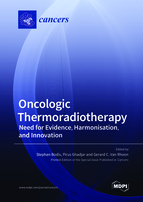Oncologic Thermoradiotherapy: Need for Evidence, Harmonisation, and Innovation
A special issue of Cancers (ISSN 2072-6694). This special issue belongs to the section "Cancer Therapy".
Deadline for manuscript submissions: closed (31 January 2022) | Viewed by 38783
Special Issue Editors
2. Department of Radiation Oncology, University Hospital Zurich, Zurich, Switzerland
Interests: evidence-based thermotherapy/hyperthermia in oncology; clinical thermoradiotherapy; hardware–software innovations in thermotherapy/hyperthermia; multidisciplinary clinical oncology; radiation oncology infrastructure in LMI countries
Interests: clinical trials; radiotherapy; electromagnetic engineering; hyperthermia; high frequency research
Interests: hyperthermia QA; thermal dose optimisation; electromagnetic antennas; MR thermometry; hyperthermia treatment planning
Special Issue Information
Dear Colleagues,
In this issue, the focus is on demonstrating the benefits of thermoradiotherapy as an ideal combined oncologic treatment modality to improve clinical outcome. In addition, the issue reports progress in soft and hard tools to guide thermal dose control and improve smooth integration of thermotherapy in the radiotherapy clinical workflow.
We hope the contributions will further substantiate clinical acceptance following earlier published randomised clinical trials and meta-analysis as well as strengthen acceptance of thermotherapy by patients, patient organisations, primary care medical staff, medical specialists, and oncologists.
Prof. Dr. Stephan Bodis
Prof. Dr. Pirus Ghadjar
Prof. Dr. Gerard C. Van Rhoon
Guest Editors
Manuscript Submission Information
Manuscripts should be submitted online at www.mdpi.com by registering and logging in to this website. Once you are registered, click here to go to the submission form. Manuscripts can be submitted until the deadline. All submissions that pass pre-check are peer-reviewed. Accepted papers will be published continuously in the journal (as soon as accepted) and will be listed together on the special issue website. Research articles, review articles as well as short communications are invited. For planned papers, a title and short abstract (about 100 words) can be sent to the Editorial Office for announcement on this website.
Submitted manuscripts should not have been published previously, nor be under consideration for publication elsewhere (except conference proceedings papers). All manuscripts are thoroughly refereed through a single-blind peer-review process. A guide for authors and other relevant information for submission of manuscripts is available on the Instructions for Authors page. Cancers is an international peer-reviewed open access semimonthly journal published by MDPI.
Please visit the Instructions for Authors page before submitting a manuscript. The Article Processing Charge (APC) for publication in this open access journal is 2900 CHF (Swiss Francs). Submitted papers should be well formatted and use good English. Authors may use MDPI's English editing service prior to publication or during author revisions.
Keywords
- thermotherapy
- regional hyperthermia
- radiation oncology
- multidisciplinary oncology
- modeling
- radiation biology









